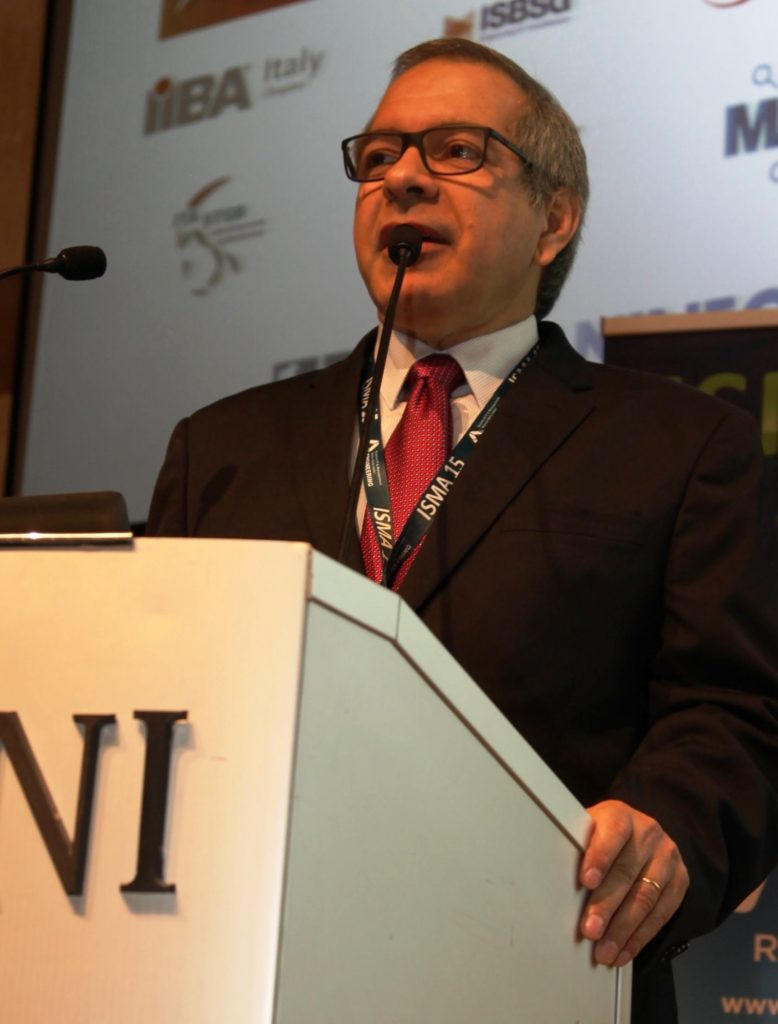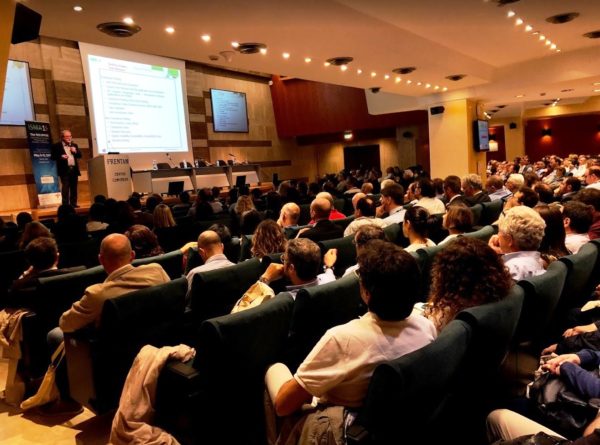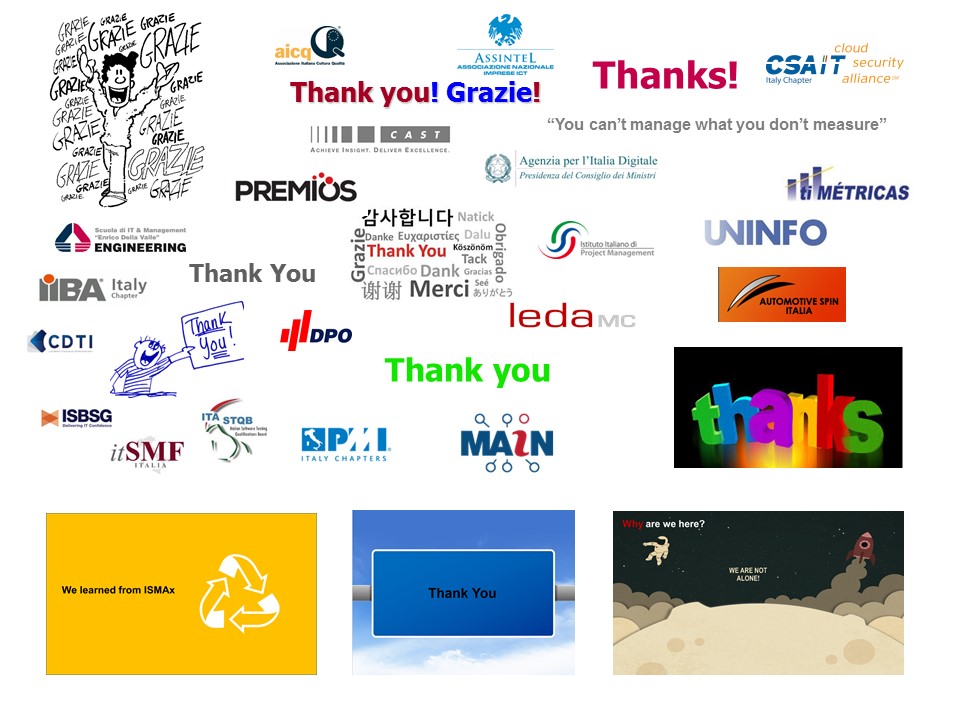Rome, Italy was the location for the ISMA 15 conference, from May 9th to May 11th, 2018. The intensive three days included four workshops with 45 attendees, an IFPUG exam with 18 new certified IFPUG CFPS and CFPP, many IFPUG board meetings and one all-day main conference with 389 people registered.

The main conference, held on May 11th, included 15 presentations and more than 20 speakers. Opening remarks were given by Mauricio Aguiar, IFPUG President, sharing the idea that “metrics are one of the best kept secrets in the IT world”. He gave thanks to GUFPI ISMA association and he announced that the next ISMA (ISMA 16) will take place in October 2018 in São Paulo, Brazil. Luigi Buglione (GUFPI ISMA president and IFPUG board member), and Filippo de Carli (GUFPI ISMA vice-president, and IFPUG education and conferences chair) shared in the opening of the conference by giving thanks to the ISMA 15 sponsors and partners, and presenting the agenda topics. You can visit the ISMA 15 photo gallery.
Thomas Fehlmann began the presentation portion of the conference with a discussion about Consumer Metrics for Privacy & Safety, with Test, Privacy, Safety and Consumer Metrics, and introducing interesting metrics models that determine Privacy Indexes based on Privacy Needs and Protection, using a graphical representation that could even be similar to the EU Energy Consumption label.
Talmon Ben-Cnaan from Israel, one of the fathers of the IFPUG SNAP method and chair of the IFPUG Non-Functional Software Sizing Committee, dealt with the topic Test Estimation science or art, starting with an open question about how many scenarios are needed to test a concrete functionality, comparing the concepts Scenario, Pairwise, and 3-way combinatorial, and sharing his powerful insights about Testing Estimation Techniques, Testing Stages & Streams, Complexity Factors, etc.
Cecilie Thormodsrud, spread in a practical and concise way that Function Points have provided a lot of benefits to Telenor Norway, company with more than 30000 employees, including being strategic for IT decisions, Productivity root cause analysis and improvements, with points of view about Do’s to succeed using Function Points, and Don’ts to be avoided while using them. Thanks for inspiring us with your success stories.
Rosangela Riccotta talked with a great deal of energy and enthusiasm about innovation and metrics in corporate governance, giving answers to how companies deal with the speed of innovation, Motivators of innovation, and Factors of innovation including Human, Organizational Culture Company Strategy and Corporate governance, and we how can innovate metrics.
Paolo Cecchini, Principal Project Management Expert at Ericsson Telecomunicazioni S.p.A. and active member of the PMI among others, shared his vision with the conference “Tracking projects performance: from analytical to strategic results” and dealt with the challenging topics Cost, Time, Scope, Quality, Priority, and Value as key words for Project success, and with the importance of having Performance Indicators (relevance indexes) about Process Adherence, Project Governance Adherence and Customer Satisfaction.
Fabrizio Di Cola, Domenico Geluardi, and Daniele Zottarel from Sogei, company with 26 IFPUG certified CFPS/CFPP, and an IFPUG FPA Function Point Counts database of around 1300 Applications and 5000 Development and Enhancement projects, focused on the challenging links between iterative and agile development and IFPUG Function Point Analysis including, applying elementary process and logical file definition in iterative development, on measurement difference between iterative software measurement and related development effort, on examples on how to use IFPUG Function Point analysis with iteration, and in effort and velocity, among others.
Carlo Capeccia, and Alberto Leardi from Leonardo S.p.A., high-tech company headquartered in Italy, focused on Aerospace, Defence and Security, and with over 45600 employees, shared their vision about Process Improvement in Software Development: “Delivering quality”, about the interesting and real experience in selecting the tool/platform to manage and to measure the quality and to have strategic metrics, how the project was piloted and setup, roadmap and lessons learned, among others.
Gianfranco Lanza demonstrates in the CEP valid conference the challenging topic “How to measure a CMS“, demonstrating that a CMS (Content Management System) can be measured using IFPUG Function Points in a standard way, giving a set of highlights and counting tips including Files concept, Elementary Processes, CMS Type Object sizes, and in the importance of being careful in the productivity calculation.

In the afternoon, Christelle Delcourt and Anne-Lies Willemen inspired the audience by their success story “Ten years of software development measurement in a Financial Market Infrastructure, Evolution Just Happens!”, reflecting the Euroclear group way in how Function Point Counting has been more than an estimation tool but also a powerful management KPI framework tool, moving from reporting figures to reporting key messages, interpreting results and identifying and understanding root causes, providing -as outside the core of the delivery expert team- objective management analysis on their software delivery performance, sharing with us that they have obtained very interesting ideas attending previous IFPUG ISMA conferences (We learned from ISMAx). They suggested that if they have been inspired by others during those events, maybe others can be inspired by their story and take away some ideas, even small ones. Thanks Christelle and Anne-Lies for sharing and spreading those ideas.
Thimoty Barbieri and Irene Rocca presented an interesting topic about how to support using JIRA the IFPUG FPA-SNAP bimodal estimation (Waterfall and Agile), as an alternative to the story point estimation, the strategic comparison between Agile (Story Points) vs FSM (Function Points), and presenting a demo of the Jira free plugin developed by them that manages in Jira the Data Functions, Transactional Functions, and resulting in Epic FPA estimation and SNAP estimations.
Eduardo Alves de Oliveira from Brazil dealt about Using FPA to Pay Software Development Contracts, and the SISP method (System of Administration of Information Technology Resources effort manual), supported by the Brazil Federal Governmental (Brazilian standard), the 23 different counting types, how contracts are paid using effort FP (SISP FP) and SLAs contracts are defined using SISP FP, examples of counting projects using SISP, and other interesting topics.
Paola Billia and Maurizio Sapienza discussed about the actual topic “Waterfall vs Agile, how can we compare them”, sharing a set of points to compare measures of Agile projects against Waterfall projects, using Function Points and SNAP Points, company historical data, measure FP Size in Agile Frameworks, and the interesting “Fit indicator” concept in addition to the traditional “Productivity” concept that provides strategic information.
The “Balloon effect: how (an improper) Scope Management can impact from Size to Effort, Duration and Costs” presented by Luigi Buglione analysed the old and the new productivity paradox, using the ABC+123 schemas, analysed the value chain to verify the sizing units used for obtaining more affordable estimates, discussing the side-effects that could take place due to the balloon effect and that only two of those sides can be accomplished, demonstrating this idea in a real balloon.
Simon Wright from United Kingdom focused on the interesting topic about Measuring the Requirement Quality and the effect of this quality in better estimates, accomplishing the goals based on how to measure the quality of the User Requirements, how to improve the quality of those requirements, and in a set of very interesting guidelines and rules for writing measurable requirements, with examples of High quality User Requirements.
At the end of the day , Federico Maria Capo, in name of IIBA Italy Chapter presented the IIBA organization and IIBA Italy Chapter, as an organization to unite a community of professionals with the goal of to be the world’s leading association for Business Analysis professionals, the concept “keep it simple but valuable” and under the title “Agile Business Analysis – Presenting IIBA Approach to Agile Delivery” presented the interesting seven Business Analysis, Agile Principles, and Applying the Principles of Agile Business Analysis at Strategy and Initiative Horizon.
In this same conference, Domenico Natale provided a set of interesting news about ISO and software standards, a group of Italian students and professors were recognized for their contribution in the metrics world (thanks), the IFPUG board were presented explaining different topics about IFPUG, GUFPI-ISMA association was presented too, an much more, all this in a nice friendship atmosphere.
Before the main conference several workshops took place including IFPUG SNAP (Software Non-functional Assessment Process) conducted by Steve Kitching discussing SNAP (SNAP is the IFPUG Software Non-functional Assessment Process that measures the non-functional requirements and it is complementary to FPA), and in the afternoon Philippe-Emmanuel Douziech and Michele Slocovich talked about CISQ (Consortium for IT Software Quality) with a focus on the Automated from Source Code positioning.
On the morning of the second day, Massimo Canducci conducted the workshop Lego Serious Play methodology as an innovative process to enhance innovation and business performance, and working with the measure and requirement concepts. In the afternoon, Roberto Meli discussed in a practical way the approximation E&QFP technique and the Functional Size Measurement Method (FSMM) Simple Function Point (SiFP), so in the theory point of view as in practice and case studies.
During the three days of the conference, many IFPUG board meetings took place, talking among others about strategic guidelines for providing the best value, and an IFPUG exam with 18 new certified IFPUG CFPS/ CFPP family, took place, too. From IFPUG, welcome to this passionate group of people that trust that metrics in the IT world are not only necessary but essential.
Thanks Italy, for your active passion and knowledge in this IT metrics world. Thanks to GUFPI-ISMA, to Luigi, to Filippo and to all the people that has been working hard for the others and for the IT metrics world. Thanks to the ISMA 15 sponsors and partners and finally, thanks to all those from different countries (United Kingdom, France, Italy, Switzerland, Brazil, Belgium, Israel, Norway, Spain, United States, Denmark, Finland, India, Greece, etc.) that has been inspired to others and by others during this ISMA event. Again, thanks Italy, and welcome ISMA 16 in Brazil.


